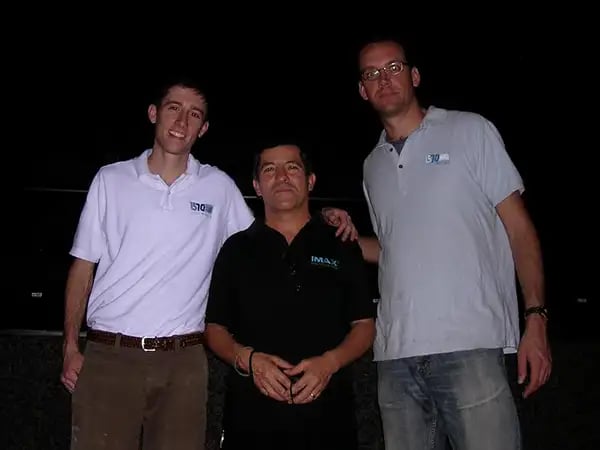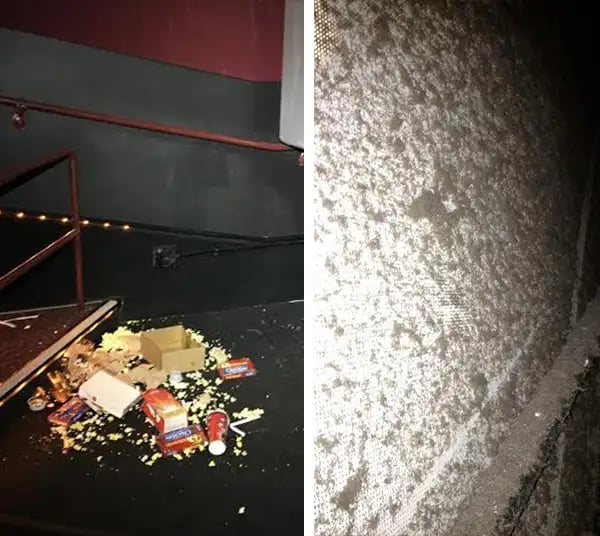Late at night, long after moviegoers have scattered from the last screening and cleaning crews have swept away popcorn remnants, Michael Quaranto begins his work.

The empty IMAX theater is quiet, dark, and palatial — almost cathedral-like — and Quaranto is its resident stagehand: He is there is cleanse the 8-story-tall, $250k screen of dust, gummy bears, and spit wads.
Cleaning a screen may seem like a simple task, but it’s such a specialized process that Quaranto is paid as much as $5k per screen for 8 hours of work.
Two decades ago, when IMAX theaters first started to gain steam, Quaranto sensed an opportunity to corner a niche market. Today, he runs what is believed to be the only large-format screen cleaning service in the country, earning nearly $1m in annual revenue.
His journey began by chance
In the early ‘90s, Quaranto, then 15-years-old, was offered a weekend job by the father of one of his high school friends.
The man, named Jeff, ran a one-of-a-kind business out of Garland, Texas: He specialized in cleaning movie theater screens.
At the time, most movie screens were made of highly durable, white perforated nylon. Aside from the occasional mop swipe from a janitor, screens were rarely cleaned. Most theaters either replaced them when they got too ratty or just let them accumulate layers of dust and nacho cheese.

Quaranto on a job (courtesy of Michael Quaranto)
Jeff had convinced cinemas all over the US that screens should be regularly cleaned. To get this work done, he recruited Quaranto, and the teen’s best friend, Andrew Brown, to travel and clean screens.
“The technique back then was to throw a bath towel over a push broom head with some velcro to keep it on,” says Quaranto. “As long as you weren’t cleaning them with gasoline, you’d be okay.”
Quaranto went on to study business marketing, and Brown engineering), at Baylor University. In the early 2000s, both became airline pilots.
On their days off, they continued to clean movie screens for Jeff’s company — and in the course of doing so, they began to notice a trend.
The beginnings of a niche industry
“Every once in a while, we’d go to one of these multiplex theaters to clean the 18 regular-sized movie screens, and the owner would say, ‘Hey, can you guys do this 80-foot-tall IMAX screen?’” recalls Quaranto.
Billed as a “radical change in the movie-going experience,” IMAX screens were up to 3x larger than standard screens, curved, and made out of more sensitive materials.
When Quaranto relayed these requests, Jeff told him the screens were “impossible to clean” and turned down the work. Nobody, he claimed, knew how to wash them.
Quaranto refused to believe that.
In 2004, he and Brown came up with a patented process for cleaning large movie screens. Then, the duo launched 1570 Cinema Services, a company geared toward IMAX screens.

Quaranto cleaning an IMAX dome theater (courtesy of Michael Quaranto)
It wasn’t long before they got their first call. Luxor Las Vegas, a casino and hotel on the strip, needed their IMAX theater (then one of only 20 in the world) cleansed of 8 years’ worth of filth.
For one night of work, Quaranto was paid $4k — and a niche industry was born.
The movie screen cleaning business
Today, Quaranto’s business, which operates out of Texas, cleans 4k screens around the world every year, from North Carolina to Australia.
The bulk of these jobs are standard 20- to 45-foot multiplex screens, secured through deals with 2 of the 3 largest cinema chains in the US. But in a typical year, he’ll also take on a dozen or so larger IMAX jobs.
Other companies could, in theory, compete with Quaranto for business. But there’s a specific catch that has allowed him to monopolize the industry.
“Screens are extremely expensive,” says Quaranto. “If it gets ruined, they have to get one custom-made that comes in from Europe, and the theater is going to be out of business for a long time. Theater operators don’t want to take a risk with new cleaning companies.”

Quaranto (left) and Brown (right) with a movie operator client (courtesy of Michael Quaranto)
Rates vary by the size of the screen, but Quaranto generally charges around $100 for a multiplex screen and can clean 15-20 of them per night. For IMAX screens, which require up to 8 hours of work, he charges up to $5k.
Though they work with small crews of trusted workers, Quaranto or Brown are on scene for every cleaning.
For “smaller” screens (up to 30 feet in height), Quaranto is able to work from the ground using aluminum extension poles fitted with towels, all custom-made. For larger screens (up to 100 feet in height), he uses a specially engineered machine rigged up to a series of pulleys — each connected to cleaning heads made of wax-coated lamb’s wool — that sweep in even vertical movements across the screen.
Oftentimes, in the dead of night in an empty theater in some unfamiliar town, Quaranto, now 42, wonders why he left a career as a pilot behind to clean screens. “It’s very lonely, dirty work,” he says. “You go to the theater, introduce yourself to the closing manager, and that’s your human interaction for the night.”
The filth he’s seen
In the course of his work, Quaranto has found nearly everything stuck to a movie screen, from gummy bears to spit wads.
“You’ll find any fluid that comes out of a human body: nacho cheese, popcorn, soft drinks,” says Quaranto. “One time, I even found a used diaper wedged in there.”

LEFT: Junk found on or near a movie screen during a cleaning; RIGHT: Typical dust build-up (courtesy of Michael Quaranto)
Mostly though, Quaranto and his crew find lots of dust — sometimes, up to a quarter-inch-thick layer. This dust, claims Quaranto, can reduce a screen’s brightness by up to 50% over time, causing the theater to ratchet up the power output on projector bulbs.
Part of the blame for this filth falls on the way operators tend to clean their theaters.
“A lot of janitors have found out the fastest way to clean a theater is with a leaf blower,” says Quaranto. “They’ll plug one into a 100-foot extension cord, start at the back, and blow all the trash — popcorn, soda cups, candy — to the front, all over the screen.”
But the main culprit is neglect.
Though Quaranto is the go-to man in the screen cleaning business, he says he only cleans about 10% of the 40k multiplex screens in the US and an even smaller percentage of the world’s 1,505 IMAX screens.
Many still choose not to clean their screens at all or, worse yet, pass on the task to the same general maintenance crew.
“It’s very easy to damage some of the newer screens,” says Quaranto. “It can’t be done effectively by the same guy who cleans the toilets.”
